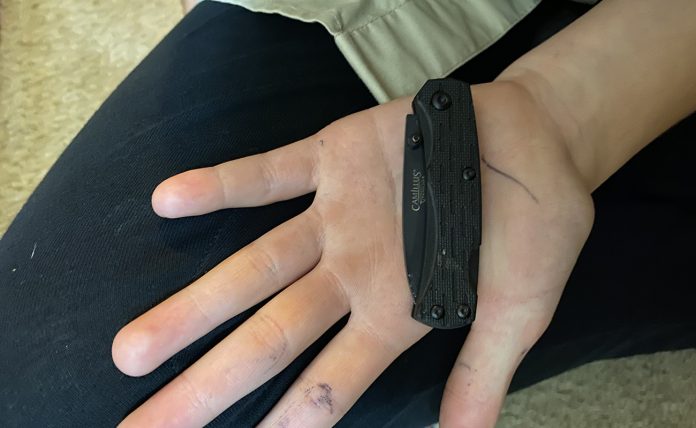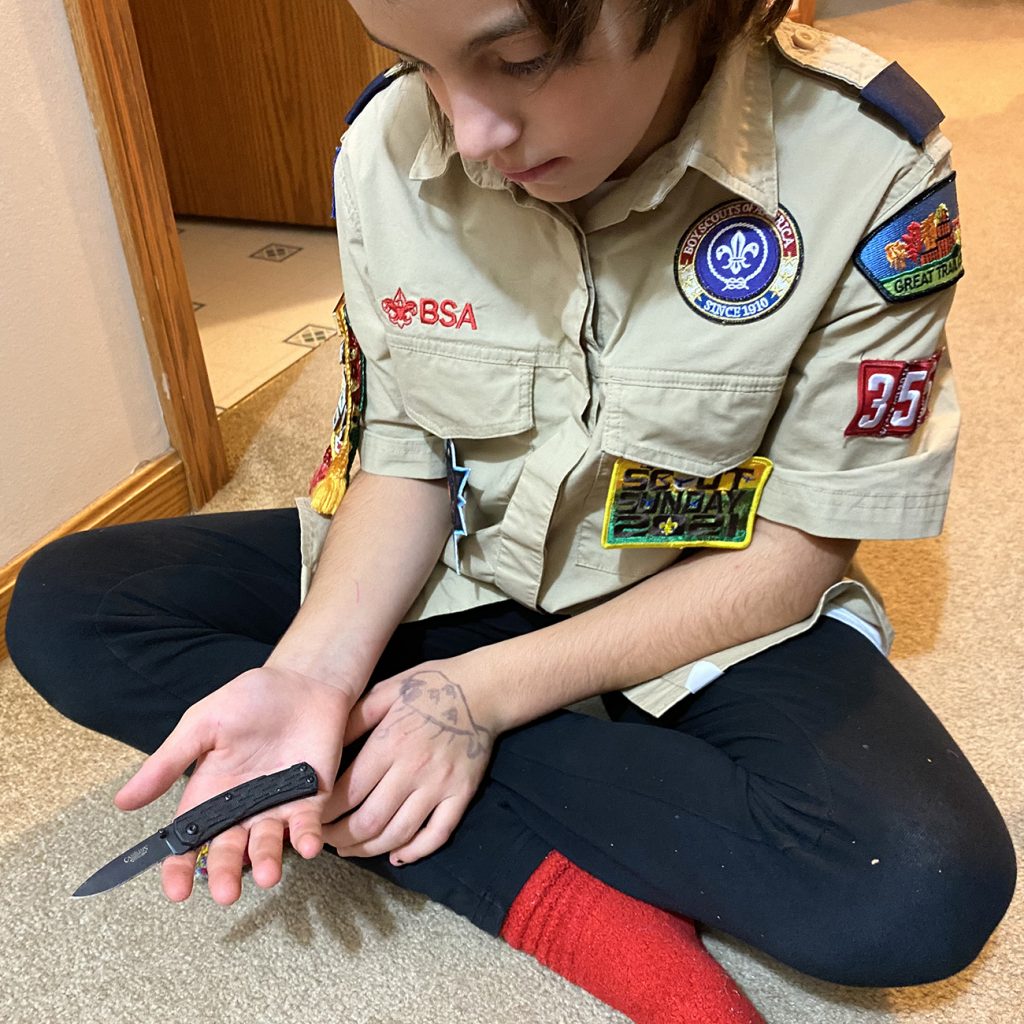
My daughter joined Cub Scouts about a year ago. She received a flyer at school and was drawn to the idea of doing more outdoor activities with other kids her age. She’s really enjoyed the camping, hiking and STEM activities, but she’s enjoyed learning more about her community and refining her survival skills just as much.
Building her own fire was a huge achievement back in May, and the novelty still hasn’t worn off. However, she’s set her sights on new goals recently — earning the right to carry a pocket knife with her at Cub Scouts meetings and events.
In order to carry a pocket knife, Vayda had to complete the requirements to earn her whittling chip. So we reviewed pocket knife safety rules and maintenance, carved traditional jack-o-lanterns out of root vegetables and recited the Pocket Knife Pledge.
After going through all the steps to help Vayd earn her whittling chip, I concluded that the Cub Scouts’ requirements are a pretty good baseline for teaching children pocket knife safety.
Below I outline considerations for teaching pocket knife safety, such as age, choosing a knife and basic safety rules.
How old should a child be before teaching pocket knife safety?
Cub Scouts that have reached the rank of Bear Scout are considered old enough to earn their whiting chip, so that’s typically a combination of 8-year-olds and 9-year-olds. In my daughter’s case, she joined late and we completed the experience when she was 10.
Ultimately, pocket knife safety should be taught at the parent’s discretion based on the maturity of the child. I knew Vayda was ready because of the way she handles school work, chores and her extracurriculars. She understands safety is imperative when handling a knife and was receptive to listening when I explained the safety guidelines and made sure she understands the responsibility of carrying a pocket knife.
How do you choose the right knife for your child?

Choosing the right knife comes down to size. Something small and easy to handle is going to be ideal for a child to learn how to use a pocket knife safely.
An ideally-sized pocket knife should be about the same size or smaller than the size of the user’s palm when it’s closed so it can be safely managed. You can determine what size is right for your child by measuring across their palm.
You should also make sure the pocket knife you choose secures in place when it is opened so that the blade is fixed when in use. This will prevent accidental injuries that could be caused by the blade slipping or moving during use.
Finally, make sure the handle of the knife you’ve chosen for your child has a secure grip to ensure better handling and more control when using the knife.
Pocket knife safety rules

- A knife is a tool, not a toy. This is the first lesson in learning to safely use a pocket knife and it’s an important one. Carrying a pocket knife is a privilege and a responsibility. Understanding that before even handling one is imperative.
- Never use a dull blade. A blunt knife requires the user to put more force on it when they are using it, which increases the possibility that it could slip and cause an accidental injury. Pocket knife blades be kept sharp by running the edge of the blade across a sharpening stone.
- Never use a dirty blade. Pocket knives should be wiped clean after every use and the hinges should be lubricated periodically with a light oil like WD-40.
- Never carry an open pocket knife. A pocket knife should always be closed when it is not in use.
- Keep your pocket knife dry. Exposure to moisture can degrade the quality of the knife by deteriorating the hinges, blade and handle, making it less efficient and more dangerous.
- Make a safety circle. Before opening a knife to use it, the user should establish a safety circle and make sure there is no one within an arm’s length in any direction. When someone else enters an established safety circle the knife should be closed until safe space is reestablished.
- Never cut towards yourself. Cutting away from yourself minimizes damage and accidents. Users should never face the blade towards their body when using a pocket knife.
- Start out small. When using the cutting blade of a pocket knife, whittling a little at a time is safer than trying to shave off big pieces or chunks. It allows the knife user to get used to the knife and maintain control.
- Never take a knife to school. Children may think it’s safe for them to carry a knife regularly or forget their pocket knife in their pants pocket and accidentally carry it to school after learning pocket knife safety. It’s important to remind them of school policies before completing your safety tutorial and go over circumstances when it’s ok to carry their pocket knife and when it should be left at home.
- Never throw a knife. This is in line with the first safety guideline but should be laid out on its own. A pocket knife is a tool that should be wielded only for its intended purpose and should not be thrown or handled in an unsafe manner.
- Never hand a knife to someone else blade first. Ideally, when handing a pocket knife to someone else it would be closed first and then reopened by the next user. However, if it is necessary to hand off an open pocket knife, it should carefully be handed off by the handle.
- Never carve into something that doesn’t belong to you. It can be exciting to learn to use a pocket knife and the desire to use it may be overwhelming. However, children should be taught that they should only use the knife as a tool on things they have permission to carve.
- Follow the rules or lose pocket knife privileges. In scouts, pocket knife privileges can be revoked if any of the above safety rules are violated. Again, pocket knives are meant to be used as tools. They are not toys. The responsibility should be taken seriously.
Safety equipment
You can protect your child’s fingers from accidental slips by providing slice-resistant gloves and finger guards.
Ideally, your child would wear their own pair of slice-resistant gloves until they’re comfortable working with a pocket knife; however, most slice-resistant gloves don’t come in children’s sizes. So you may have trouble finding slice-resistant gloves that fit your child.
There are a couple of alternatives you might consider. Batting gloves for baseball are a good alternative because they are lined with thicker leather around the thumb and index finger and they are more widely available. Finger guards are another option. Slide on guards may be too big, but finger guards made from self-adhering athletic tape work well.
Easy-to-carve media
Choosing the right media to teach a beginner how to use a pocket knife is crucial to allow them to safely develop their knife-handling skills. Here is a list of safe media to start out on:
- A bar of soap
- Fruits and vegetables
- Candles
- Modeling clay
- A soft wood, like balsa wood or air-dried basswood










